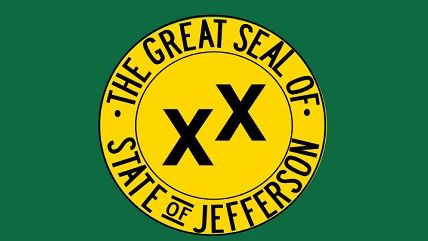Jefferson Staters Keeping Up Fight in California
At Sacramento rally, rural residents say Legislature has ignored their issues

In Siskiyou County, Calif., the tax base is so small and land area so vast the county's 44,000 residents have to rely on themselves in an emergency. The county can only afford a slim law-enforcement presence, so if there's a problem the response time may be "basically never," explains Mark Baird, a rancher and retired deputy sheriff who met with me in a Sacramento coffee shop last Wednesday.
Yet, he pointed out, Senate President Pro Tempore Kevin de Leon (D-Los Angeles) just announced his support for more expansive gun-control measures. That disconnect between rural residents, who rely on their guns for self protection, and the more urban-oriented priorities at the Capitol, is an example of why he drove to the Capitol this week.
Baird is a leader of the ongoing effort to carve out rural northern California counties (and in past proposals, some southern Oregon counties, also) into the 51st state of Jefferson. The idea got a burst of attention in 2014 when Silicon Valley entrepreneur Tim Draper tried (and failed) to place on the ballot a measure that would break California into six states, one of which would have been called Jefferson.
But while the attention faded away, the Jefferson movement—the continuation of an effort that got its start in the World War II era—has plugged along. Baird was here to present "declarations" from 15 of California's 58 counties calling for withdrawal from California. The group held a rally on the west steps of the Capitol.
Those petitions—some approved by majorities of boards of supervisors, others comprised of signatures from local voters—were dropped off at the Legislative Counsel's Office, where they will no doubt be duly ignored from legislative leaders.
Such efforts are easy to dismiss, but it's too bad it has to be that way. Unlike the armed Bundy activists who have taken over a federal wildlife center in eastern Oregon, these Jefferson activists are petitioning their government in a thoughtful and peaceful manner. They may be tilting at windmills, but such protests are as American as apple pie.
Baird and Fort Jones Mayor Tom McCulley explained to me some of their frustrations. Their towns used to be thriving rural communities, but state and federal environmental policies dried up economic opportunities in logging, farming, energy development and mining. Now, McCulley said, the top employers in the county are county, state and federal government. Their kids are moving away and not coming back because of a lack of opportunity.
They gave numerous examples of officials coming in and making unreasonable demands, such as the requirement that McCulley's town of 650 spend $5 million on a new sewage facility, or restrictions on harvesting dead trees, or a federal agency's taking of half of one town's water supply, or state air restrictions that shut down a remote seed pellet mill. "Its government from afar with no empathy with how we live and we lack the representation to do anything about it," Baird said.
Indeed, their arguments were not mainly about grievances, but about political representation. At the Capitol rally, attended by several hundred people, I saw this sign: "Rural areas need proper representation." As one speaker noted, "This is not secession." He then invoked the Federalist papers No. 51, an essay about the proper way to construct a legislature. Baird points to a 1964 U.S. Supreme Court case that forced legislatures to base representation solely on population (rather than having Senate seats divvied up by county). In fact, their next step is a federal lawsuit based on these representation issues.
Those counties that would be part of the new state tend to have some of the lowest populations in California. Colusa has around 21,000 people. Sierra has 3,000 and Trinity has nearly 14,000 people. Those are rounding errors in most Southern California cities. Obviously, it's hard to get much attention to their concerns in a Legislature dominated by representatives from counties with millions of people.
These representation concerns seem authentic. I was driving through Yuba County over the weekend and heard radio ads promoting Jefferson. I've seen the Double-X flag (standing for residents having been double-crossed by politicians in Sacramento and Salem) flying all across the north state. The sentiment isn't unanimous, of course. Sierra County's board of supervisors recently passed a resolution opposing Jefferson. But even their resolution acknowledges many of the same problems—they just want to solve them within current boundaries.
A large portion of residents in a region that encompasses around 30 percent of the state's land mass are so frustrated they want to create a new state. That's the sign of a problem. California's legislators and governor—who has a family ranch in Colusa County and who has been quoted saying that he'd like to convince Jefferson activists to "stick around"—ought to take their concerns more seriously.


Show Comments (29)